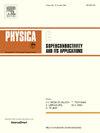Influence of fluctuant external magnetic field on the lateral unrecoverable distance of HTS bulks
IF 1
3区 物理与天体物理
Q4 PHYSICS, APPLIED
Physica C-superconductivity and Its Applications
Pub Date : 2025-01-16
DOI:10.1016/j.physc.2025.1354656
引用次数: 0
Abstract
High temperature superconducting (HTS) maglev has great potential for high-speed rail transportation due to its non-contact nature, simple structure, and environmental benefits. The lateral stability of the HTS bulk superconductor is crucial for the curve negotiation ability of maglev trains running at high speeds. The HTS bulk can provide guidance for the maglev train without active control due to its unique magnetic flux pinning property. However, when passing through curves, it can deviate from its original position due to centrifugal effects and may not fully return to its original position. This deviation, known as the unrecoverable distance (UD), is closely related to the guidance performance of the maglev system. In this paper, the lateral UD of the HTS bulk is analyzed through lateral round-trip guidance force experiments using a customized HTS maglev dynamic measurement platform (SCML-03) with a circular permanent magnet guideway (PMG). The guidance force under different rotational speeds of the PMG was tested to study the effect of the fluctuation frequency of the external magnetic field. The influence of maximum lateral displacement (MLD), field cooling height (FCH), and working height (WH) on the UD of the HTS bulk are also discussed. The results showed that the rotational speed of the PMG has little effect on the dynamic guidance performance. The UD can be reduced by lowering the FCH and raising the WH appropriately. Additionally, methods should be found to restrain the possible MLD of levitated vehicles. This experimental analysis shows the lateral recoverable performance of the HTS bulk and provides a reference for the future design of the HTS maglev train.
外磁场波动对高温超导体侧向不可恢复距离的影响
高温超导磁浮具有非接触、结构简单、环保等优点,在高速铁路运输中具有很大的应用潜力。高温超导体超导体的横向稳定性对高速运行的磁悬浮列车曲线通过能力至关重要。高温超导体具有独特的磁钉特性,可以在无主动控制的情况下为磁悬浮列车提供导航。但是,在经过曲线时,由于离心作用,它可能会偏离原来的位置,不能完全回到原来的位置。这种偏差被称为不可恢复距离(UD),与磁悬浮系统的制导性能密切相关。本文利用定制的带有圆形永磁导轨(PMG)的HTS磁悬浮动态测量平台(SCML-03),通过横向往返制导力实验,分析了HTS主体的横向UD。测试了不同转速下永磁转子的导引力,研究了外磁场波动频率对永磁转子导引力的影响。讨论了最大侧向位移(MLD)、现场冷却高度(FCH)和工作高度(WH)对高温超导体UD的影响。结果表明,PMG的转速对动态制导性能影响不大。可通过适当降低FCH和提高WH来降低UD。此外,还应找到抑制悬浮车辆可能产生的MLD的方法。通过实验分析,揭示了高速列车主体的横向可恢复性能,为高速列车的设计提供参考。
本文章由计算机程序翻译,如有差异,请以英文原文为准。
求助全文
约1分钟内获得全文
求助全文
来源期刊
CiteScore
2.70
自引率
11.80%
发文量
102
审稿时长
66 days
期刊介绍:
Physica C (Superconductivity and its Applications) publishes peer-reviewed papers on novel developments in the field of superconductivity. Topics include discovery of new superconducting materials and elucidation of their mechanisms, physics of vortex matter, enhancement of critical properties of superconductors, identification of novel properties and processing methods that improve their performance and promote new routes to applications of superconductivity.
The main goal of the journal is to publish:
1. Papers that substantially increase the understanding of the fundamental aspects and mechanisms of superconductivity and vortex matter through theoretical and experimental methods.
2. Papers that report on novel physical properties and processing of materials that substantially enhance their critical performance.
3. Papers that promote new or improved routes to applications of superconductivity and/or superconducting materials, and proof-of-concept novel proto-type superconducting devices.
The editors of the journal will select papers that are well written and based on thorough research that provide truly novel insights.

 求助内容:
求助内容: 应助结果提醒方式:
应助结果提醒方式:


